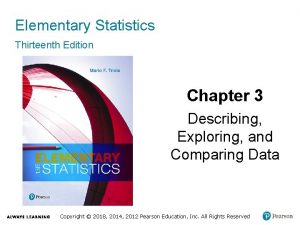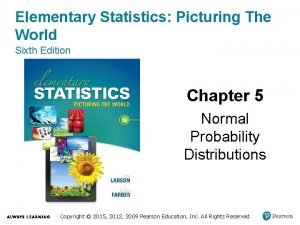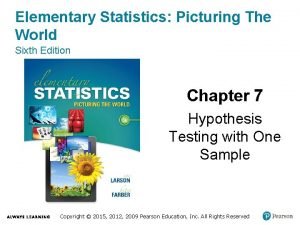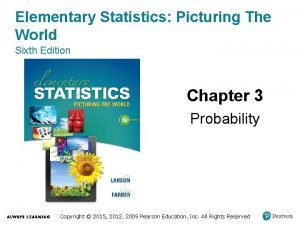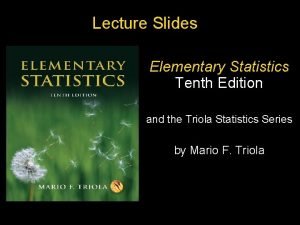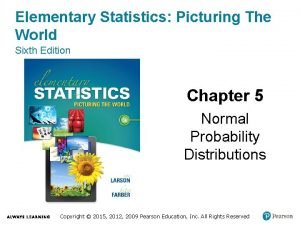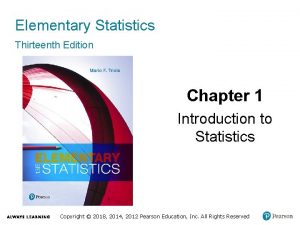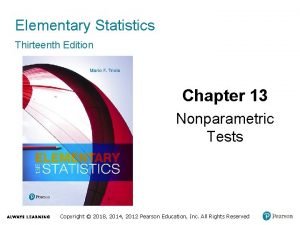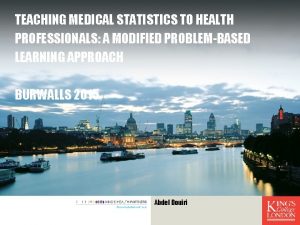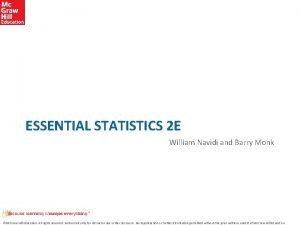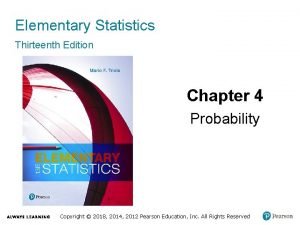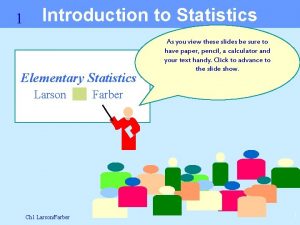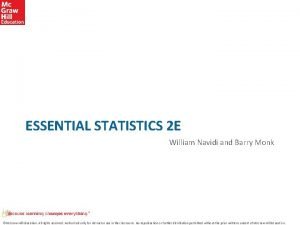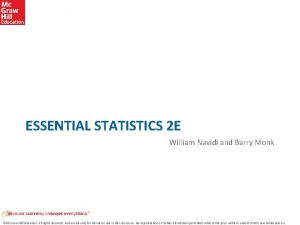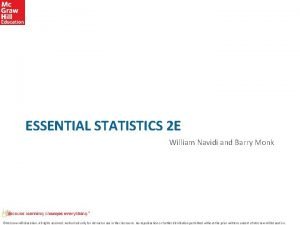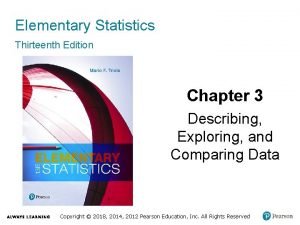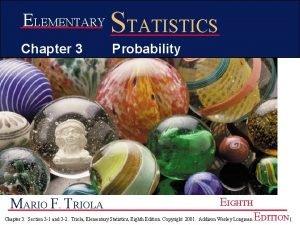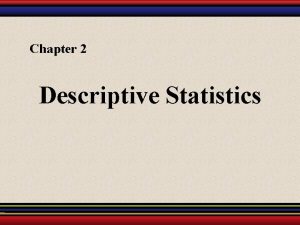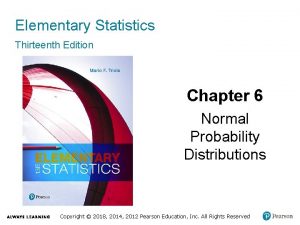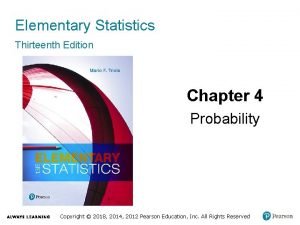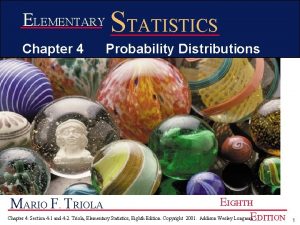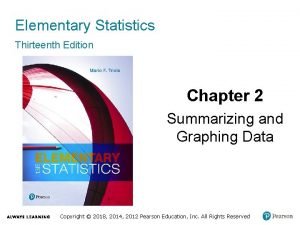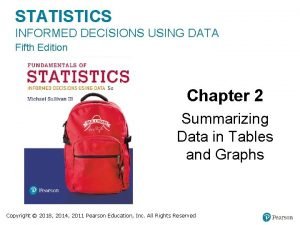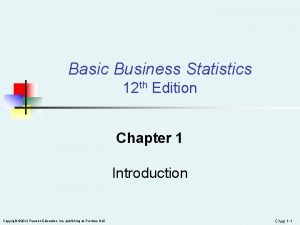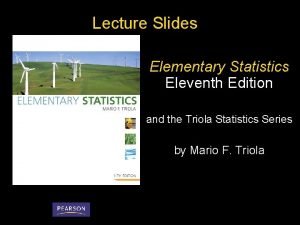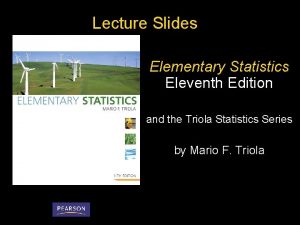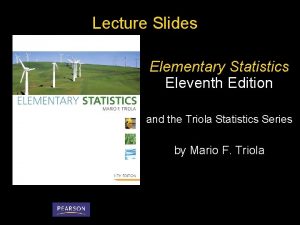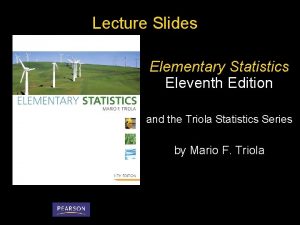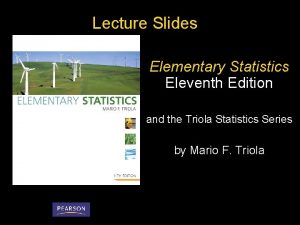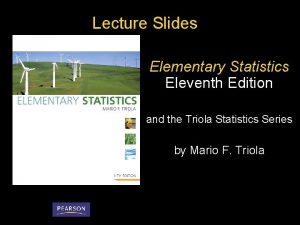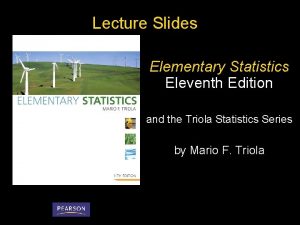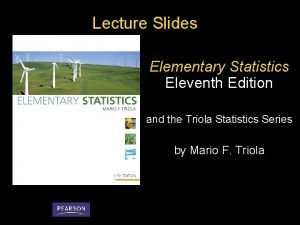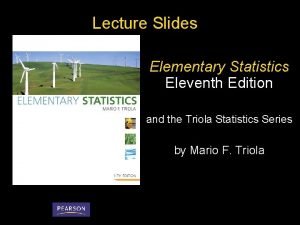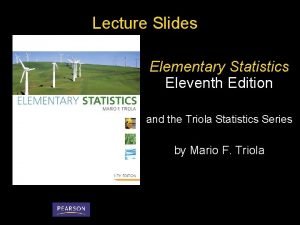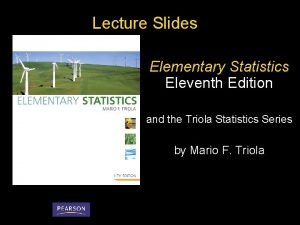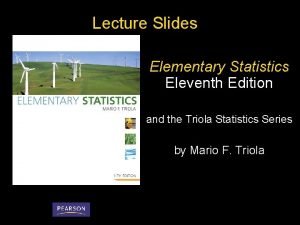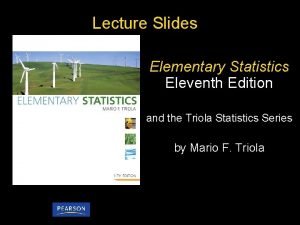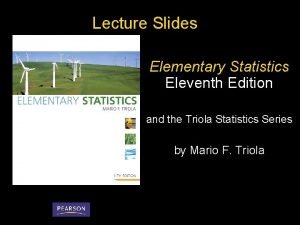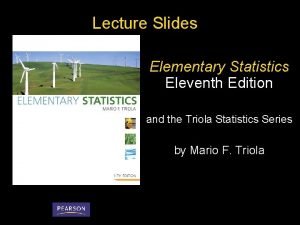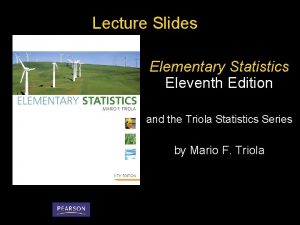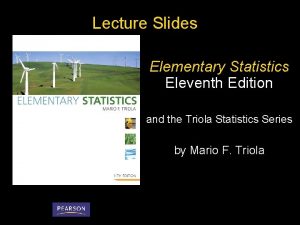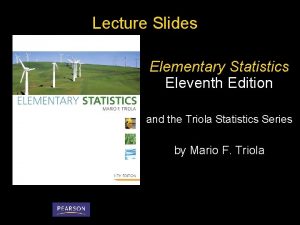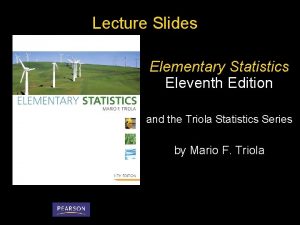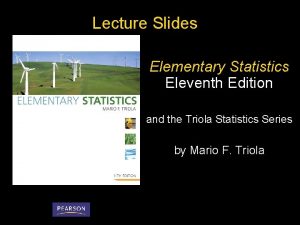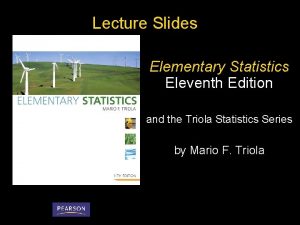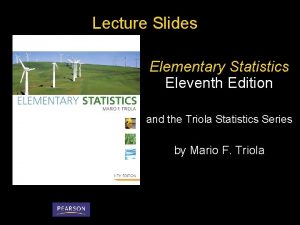Lecture Slides Elementary Statistics Eleventh Edition and the

























































- Slides: 57

Lecture Slides Elementary Statistics Eleventh Edition and the Triola Statistics Series by Mario F. Triola Copyright © 2010, 2007, 2004 Pearson Education, Inc. 2. 1 - 1

Chapter 2 Summarizing and Graphing Data 2 -1 Review and Preview 2 -2 Frequency Distributions 2 -3 Histograms 2 -4 Statistical Graphics 2 -5 Critical Thinking: Bad Graphs 2. 1 - 2

Section 2 -1 Review and Preview Copyright © 2010, 2007, 2004 Pearson Education, Inc. 2. 1 - 3

Preview Important Characteristics of Data 1. Center: A representative or average value that indicates where the middle of the data set is located. 2. Variation: A measure of the amount that the data values vary. 3. Distribution: The nature or shape of the spread of data over the range of values (such as bell-shaped, uniform, or skewed). 4. Outliers: Sample values that lie very far away from the vast majority of other sample values. 5. Time: Changing characteristics of the data over time. Copyright © 2010, 2007, 2004 Pearson Education, Inc. 2. 1 - 4

Section 2 -2 Frequency Distributions Copyright © 2010, 2007, 2004 Pearson Education, Inc. 2. 1 - 5

Key Concept When working with large data sets, it is often helpful to organize and summarize data by constructing a table called a frequency distribution, defined later. Because computer software and calculators can generate frequency distributions, the details of constructing them are not as important as what they tell us about data sets. It helps us understand the nature of the distribution of a data set. Copyright © 2010, 2007, 2004 Pearson Education, Inc. 2. 1 - 6

Definition v Frequency Distribution (or Frequency Table) shows how a data set is partitioned among all of several categories (or classes) by listing all of the categories along with the number of data values in each of the categories. Copyright © 2010, 2007, 2004 Pearson Education, Inc. 2. 1 - 7

Pulse Rates of Females and Males Original Data Copyright © 2010, 2007, 2004 Pearson Education, Inc. 2. 1 - 8

Frequency Distribution Pulse Rates of Females The frequency for a particular class is the number of original values that fall into that class. Copyright © 2010, 2007, 2004 Pearson Education, Inc. 2. 1 - 9

Frequency Distributions Definitions Copyright © 2010, 2007, 2004 Pearson Education, Inc. 2. 1 - 10

Lower Class Limits are the smallest numbers that can actually belong to different classes Lower Class Limits Copyright © 2010, 2007, 2004 Pearson Education, Inc. 2. 1 - 11

Upper Class Limits are the largest numbers that can actually belong to different classes Upper Class Limits Copyright © 2010, 2007, 2004 Pearson Education, Inc. 2. 1 - 12

Class Boundaries are the numbers used to separate classes, but without the gaps created by class limits 59. 5 69. 5 Class Boundaries 79. 5 89. 5 99. 5 109. 5 119. 5 129. 5 Copyright © 2010, 2007, 2004 Pearson Education, Inc. 2. 1 - 13

Class Midpoints are the values in the middle of the classes and can be found by adding the lower class limit to the upper class limit and dividing the sum by two 64. 5 74. 5 Class Midpoints 84. 5 94. 5 104. 5 114. 5 124. 5 Copyright © 2010, 2007, 2004 Pearson Education, Inc. 2. 1 - 14

Class Width is the difference between two consecutive lower class limits or two consecutive lower class boundaries 10 Class Width 10 10 10 Copyright © 2010, 2007, 2004 Pearson Education, Inc. 2. 1 - 15

Reasons for Constructing Frequency Distributions 1. Large data sets can be summarized. 2. We can analyze the nature of data. 3. We have a basis for constructing important graphs. Copyright © 2010, 2007, 2004 Pearson Education, Inc. 2. 1 - 16

Constructing A Frequency Distribution 1. Determine the number of classes (should be between 5 and 20). 2. Calculate the class width (round up). class width (maximum value) – (minimum value) number of classes 3. Starting point: Choose the minimum data value or a convenient value below it as the first lower class limit. 4. Using the first lower class limit and class width, proceed to list the other lower class limits. 5. List the lower class limits in a vertical column and proceed to enter the upper class limits. 6. Take each individual data value and put a tally mark in the appropriate class. Add the tally marks to get the frequency. Copyright © 2010, 2007, 2004 Pearson Education, Inc. 2. 1 - 17

Relative Frequency Distribution includes the same class limits as a frequency distribution, but the frequency of a class is replaced with a relative frequencies (a proportion) or a percentage frequency ( a percent) relative frequency = class frequency sum of all frequencies class frequency percentage = 100% frequency sum of all frequencies Copyright © 2010, 2007, 2004 Pearson Education, Inc. 2. 1 - 18

Relative Frequency Distribution * Total Frequency = 40 Copyright © 2010, 2007, 2004 Pearson Education, Inc. * 12/40 100 = 30% 2. 1 - 19

Cumulative Frequencies Cumulative Frequency Distribution Copyright © 2010, 2007, 2004 Pearson Education, Inc. 2. 1 - 20

Frequency Tables Copyright © 2010, 2007, 2004 Pearson Education, Inc. 2. 1 - 21

Critical Thinking Interpreting Frequency Distributions In later chapters, there will be frequent reference to data with a normal distribution. One key characteristic of a normal distribution is that it has a “bell” shape. v The frequencies start low, then increase to one or two high frequencies, then decrease to a low frequency. v The distribution is approximately symmetric, with frequencies preceding the maximum being roughly a mirror image of those that follow the maximum. Copyright © 2010, 2007, 2004 Pearson Education, Inc. 2. 1 - 22

Gaps v Gaps The presence of gaps can show that we have data from two or more different populations. However, the converse is not true, because data from different populations do not necessarily result in gaps. Copyright © 2010, 2007, 2004 Pearson Education, Inc. 2. 1 - 23

Recap In this Section we have discussed v Important characteristics of data v Frequency distributions v Procedures for constructing frequency distributions v Relative frequency distributions v Cumulative frequency distributions Copyright © 2010, 2007, 2004 Pearson Education, Inc. 2. 1 - 24

Section 2 -3 Histograms Copyright © 2010, 2007, 2004 Pearson Education, Inc. 2. 1 - 25

Key Concept We use a visual tool called a histogram to analyze the shape of the distribution of the data. Copyright © 2010, 2007, 2004 Pearson Education, Inc. 2. 1 - 26

Histogram A graph consisting of bars of equal width drawn adjacent to each other (without gaps). The horizontal scale represents the classes of quantitative data values and the vertical scale represents the frequencies. The heights of the bars correspond to the frequency values. Copyright © 2010, 2007, 2004 Pearson Education, Inc. 2. 1 - 27

Histogram Basically a graphic version of a frequency distribution. Copyright © 2010, 2007, 2004 Pearson Education, Inc. 2. 1 - 28

Histogram The bars on the horizontal scale are labeled with one of the following: (1) Class boundaries (2) Class midpoints (3) Lower class limits (introduces a small error) Horizontal Scale for Histogram: Use class boundaries or class midpoints. Vertical Scale for Histogram: Use the class frequencies. Copyright © 2010, 2007, 2004 Pearson Education, Inc. 2. 1 - 29

Relative Frequency Histogram Has the same shape and horizontal scale as a histogram, but the vertical scale is marked with relative frequencies instead of actual frequencies Copyright © 2010, 2007, 2004 Pearson Education, Inc. 2. 1 - 30

Critical Thinking Interpreting Histograms Objective is not simply to construct a histogram, but rather to understand something about the data. When graphed, a normal distribution has a “bell” shape. Characteristic of the bell shape are (1) The frequencies increase to a maximum, and then decrease, and (2) symmetry, with the left half of the graph roughly a mirror image of the right half. The histogram on the next slide illustrates this. Copyright © 2010, 2007, 2004 Pearson Education, Inc. 2. 1 - 31

Critical Thinking Interpreting Histograms Copyright © 2010, 2007, 2004 Pearson Education, Inc. 2. 1 - 32

Recap In this Section we have discussed v Histograms v Relative Frequency Histograms Copyright © 2010, 2007, 2004 Pearson Education, Inc. 2. 1 - 33

Section 2 -4 Statistical Graphics Copyright © 2010, 2007, 2004 Pearson Education, Inc. 2. 1 - 34

Key Concept This section discusses other types of statistical graphs. Our objective is to identify a suitable graph for representing the data set. The graph should be effective in revealing the important characteristics of the data. Copyright © 2010, 2007, 2004 Pearson Education, Inc. 2. 1 - 35

Frequency Polygon Uses line segments connected to points directly above class midpoint values Copyright © 2010, 2007, 2004 Pearson Education, Inc. 2. 1 - 36

Relative Frequency Polygon Uses relative frequencies (proportions or percentages) for the vertical scale. Copyright © 2010, 2007, 2004 Pearson Education, Inc. 2. 1 - 37

Ogive A line graph that depicts cumulative frequencies Copyright © 2010, 2007, 2004 Pearson Education, Inc. 2. 1 - 38

Dot Plot Consists of a graph in which each data value is plotted as a point (or dot) along a scale of values. Dots representing equal values are stacked. Copyright © 2010, 2007, 2004 Pearson Education, Inc. 2. 1 - 39

Stemplot (or Stem-and-Leaf Plot) Represents quantitative data by separating each value into two parts: the stem (such as the leftmost digit) and the leaf (such as the rightmost digit) Pulse Rates of Females Copyright © 2010, 2007, 2004 Pearson Education, Inc. 2. 1 - 40

Bar Graph Uses bars of equal width to show frequencies of categories of qualitative data. Vertical scale represents frequencies or relative frequencies. Horizontal scale identifies the different categories of qualitative data. A multiple bar graph has two or more sets of bars, and is used to compare two or more data sets. Copyright © 2010, 2007, 2004 Pearson Education, Inc. 2. 1 - 41

Multiple Bar Graph Median Income of Males and Females Copyright © 2010, 2007, 2004 Pearson Education, Inc. 2. 1 - 42

Pareto Chart A bar graph for qualitative data, with the bars arranged in descending order according to frequencies Copyright © 2010, 2007, 2004 Pearson Education, Inc. 2. 1 - 43

Pie Chart A graph depicting qualitative data as slices of a circle, size of slice is proportional to frequency count Copyright © 2010, 2007, 2004 Pearson Education, Inc. 2. 1 - 44

Scatter Plot (or Scatter Diagram) A plot of paired (x, y) data with a horizontal x-axis and a vertical y-axis. Used to determine whethere is a relationship between the two variables Copyright © 2010, 2007, 2004 Pearson Education, Inc. 2. 1 - 45

Time-Series Graph Data that have been collected at different points in time: time-series data Copyright © 2010, 2007, 2004 Pearson Education, Inc. 2. 1 - 46

Important Principles Suggested by Edward Tufte For small data sets of 20 values or fewer, use a table instead of a graph. A graph of data should make the viewer focus on the true nature of the data, not on other elements, such as eye-catching but distracting design features. Do not distort data, construct a graph to reveal the true nature of the data. Almost all of the ink in a graph should be used for the data, not the other design elements. Copyright © 2010, 2007, 2004 Pearson Education, Inc. 2. 1 - 47

Important Principles Suggested by Edward Tufte Don’t use screening consisting of features such as slanted lines, dots, cross-hatching, because they create the uncomfortable illusion of movement. Don’t use area or volumes for data that are actually one-dimensional in nature. (Don’t use drawings of dollar bills to represent budget amounts for different years. ) Never publish pie charts, because they waste ink on nondata components, and they lack appropriate scale. Copyright © 2010, 2007, 2004 Pearson Education, Inc. 2. 1 - 48

Car Reliability Data Copyright © 2010, 2007, 2004 Pearson Education, Inc. 2. 1 - 49

Recap In this section we saw that graphs are excellent tools for describing, exploring and comparing data. Describing data: Histogram - consider distribution, center, variation, and outliers. Exploring data: features that reveal some useful and/or interesting characteristic of the data set. Comparing data: Construct similar graphs to compare data sets. Copyright © 2010, 2007, 2004 Pearson Education, Inc. 2. 1 - 50

Section 2 -5 Critical Thinking: Bad Graphs Copyright © 2010, 2007, 2004 Pearson Education, Inc. 2. 1 - 51

Key Concept Some graphs are bad in the sense that they contain errors. Some are bad because they are technically correct, but misleading. It is important to develop the ability to recognize bad graphs and identify exactly how they are misleading. Copyright © 2010, 2007, 2004 Pearson Education, Inc. 2. 1 - 52

Nonzero Axis Are misleading because one or both of the axes begin at some value other than zero, so that differences are exaggerated. Copyright © 2010, 2007, 2004 Pearson Education, Inc. 2. 1 - 53

Pictographs are drawings of objects. Three-dimensional objects money bags, stacks of coins, army tanks (for army expenditures), people (for population sizes), barrels (for oil production), and houses (for home construction) are commonly used to depict data. These drawings can create false impressions that distort the data. If you double each side of a square, the area does not merely double; it increases by a factor of four; if you double each side of a cube, the volume does not merely double; it increases by a factor of eight. Pictographs using areas and volumes can therefore be very misleading. Copyright © 2010, 2007, 2004 Pearson Education, Inc. 2. 1 - 54

Annual Incomes of Groups with Different Education Levels Bars have same width, too busy, too difficult to understand. Copyright © 2010, 2007, 2004 Pearson Education, Inc. 2. 1 - 55

Annual Incomes of Groups with Different Education Levels Misleading. Depicts one-dimensional data with threedimensional boxes. Last box is 64 times as large as first box, but income is only 4 times as large. Copyright © 2010, 2007, 2004 Pearson Education, Inc. 2. 1 - 56

Annual Incomes of Groups with Different Education Levels Fair, objective, unencumbered by distracting features. Copyright © 2010, 2007, 2004 Pearson Education, Inc. 2. 1 - 57
 Eleventh edition management
Eleventh edition management Management stephen p robbins 11th edition
Management stephen p robbins 11th edition Management eleventh edition
Management eleventh edition Management eleventh edition stephen p robbins
Management eleventh edition stephen p robbins Elementary statistics 13th edition answers
Elementary statistics 13th edition answers Picturing distributions with graphs
Picturing distributions with graphs P value
P value Elementary statistics picturing the world 6th edition
Elementary statistics picturing the world 6th edition Elementary statistics tenth edition
Elementary statistics tenth edition Elementary statistics picturing the world 6th edition
Elementary statistics picturing the world 6th edition Elementary statistics 13th edition chapter 1
Elementary statistics 13th edition chapter 1 Elementary statistics 13th edition
Elementary statistics 13th edition Eleventh 5 year plan
Eleventh 5 year plan Eleventh 5 year plan
Eleventh 5 year plan 11th five year plan
11th five year plan For his eleventh birthday elvis presley
For his eleventh birthday elvis presley A small child slides down the four frictionless slides
A small child slides down the four frictionless slides Ball a has half the mass and eight times
Ball a has half the mass and eight times Principles of economics powerpoint lecture slides
Principles of economics powerpoint lecture slides Introduction to machine learning slides
Introduction to machine learning slides Business communication lecture slides
Business communication lecture slides 01:640:244 lecture notes - lecture 15: plat, idah, farad
01:640:244 lecture notes - lecture 15: plat, idah, farad Elementary and middle school mathematics 10th edition
Elementary and middle school mathematics 10th edition Medical statistics lecture
Medical statistics lecture Elementary statistics william navidi pdf
Elementary statistics william navidi pdf 5% guideline for cumbersome calculations
5% guideline for cumbersome calculations Introduction to elementary statistics
Introduction to elementary statistics Essential statistics william navidi pdf
Essential statistics william navidi pdf William navidi elementary statistics pdf
William navidi elementary statistics pdf William navidi elementary statistics pdf
William navidi elementary statistics pdf Elementary statistics chapter 3
Elementary statistics chapter 3 What will be the probability of an impossible event
What will be the probability of an impossible event Elementary statistics chapter 2
Elementary statistics chapter 2 Elementary statistics chapter 6
Elementary statistics chapter 6 Elementary statistics chapter 4
Elementary statistics chapter 4 Margin of error adalah
Margin of error adalah Elementary statistics chapter 4
Elementary statistics chapter 4 Elementary statistics chapter 2
Elementary statistics chapter 2 Using mis 10th edition
Using mis 10th edition Using mis 10th edition
Using mis 10th edition Statistics informed decisions using data 5th edition pdf
Statistics informed decisions using data 5th edition pdf Basic business statistics 12th edition
Basic business statistics 12th edition Statistics: unlocking the power of data 1st edition
Statistics: unlocking the power of data 1st edition The practice of statistics third edition
The practice of statistics third edition Introduction to statistics what is statistics
Introduction to statistics what is statistics Hát kết hợp bộ gõ cơ thể
Hát kết hợp bộ gõ cơ thể Bổ thể
Bổ thể Tỉ lệ cơ thể trẻ em
Tỉ lệ cơ thể trẻ em Voi kéo gỗ như thế nào
Voi kéo gỗ như thế nào Chụp phim tư thế worms-breton
Chụp phim tư thế worms-breton Chúa sống lại
Chúa sống lại Môn thể thao bắt đầu bằng từ đua
Môn thể thao bắt đầu bằng từ đua Thế nào là hệ số cao nhất
Thế nào là hệ số cao nhất Các châu lục và đại dương trên thế giới
Các châu lục và đại dương trên thế giới Công thức tiính động năng
Công thức tiính động năng Trời xanh đây là của chúng ta thể thơ
Trời xanh đây là của chúng ta thể thơ Mật thư tọa độ 5x5
Mật thư tọa độ 5x5




